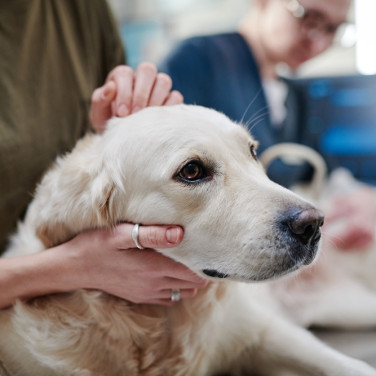DISEASES
Mast Cell Tumor (MCT) in Dogs - Diagnosis, Treatment, and Prognosis
페이지 정보
본문


What is a mast cell tumor (MCT) in dogs?
Mast cell tumors are the most common type of skin tumor in dogs. These tumors arise from the malignant proliferation of mast cells, which are a type of white blood cell that plays a vital role in allergic reactions. Although mast cell tumors often form as a single mass on the skin, they can also spread to other organs, including the spleen, liver, intestine, and bone marrow.
Causes of mast cell tumors in dogs
Although the cause of mast cell tumors has not been definitively identified, it is believed to be the result of a combination of factors, including genetics and environmental factors. Specifically, mastocytoma is thought to develop as a result of mutations in the KIT gene, which is involved in regulating cell division. While this type of tumor can occur in any breed, certain breeds are more prone to it.
- Pug, Boxer, Boston Terrier, Bull Mastiff, English Bulldog, Shar Pei, Labrador Retriever
Symptoms and signs of mast cell tumors in dogs

Although most mast cell tumors manifest symptoms limited to the skin, the presence and severity of accompanying symptoms may vary depending on the tumor's malignancy level.
-
Skin symptoms
Mast cell tumors can present in various forms, with some appearing as small, slow-growing tumors on the skin, while others are large and rapidly growing, causing itching, inflammation, swelling, and ulceration, and may appear to fluctuate in size. In addition, some tumors may be observed as soft, movable lumps under the skin.
-
Digestive symptoms
Mast cells secrete a substance known as histamine that can lead to the formation of ulcers in the stomach or intestines. Histamine can trigger an allergic reaction that often comes with unpleasant symptoms such as anorexia, vomiting, and diarrhea.
-
Other various symptoms
Mast cell tumors located on the skin have the potential to metastasize to nearby lymph nodes. This metastasis often results in the enlargement of superficial lymph nodes, which can be felt as lumps under the skin. It is also worth mentioning that this enlargement may be accompanied by nonspecific symptoms.
What are the risks of mast cell tumors in dogs and when to see a vet
Mast cell tumors can be invasive and it is crucial to remove them while they are small. If any of the aforementioned symptoms associated with mast cell tumors are noticed, it is recommended to seek medical attention promptly for early diagnosis and treatment.
In general, if an unidentified mass appears on the skin and is larger than 1 cm in diameter, grows rapidly, or persists in its growth, it is advisable to visit a hospital for examination since it may likely be a malignant tumor.
If your dog experiences discomfort or pain from the mass or if there is any redness or discharge around the mass, a thorough examination to confirm the condition is also recommended.
Home treatments for mast cell tumors in dogs
Mast cell tumors are a type of tumor that cannot be treated at home, so it is important to seek proper diagnosis and treatment by going to the hospital once a tumor is identified. To ensure effective management of the tumor, it is essential to keep the area around the mass clean and monitor it regularly to check for rapid growth or any signs of discomfort. If there are any wounds around the mass, they can be disinfected using an antiseptic that is specifically designed for use on animal skin.
Diagnosing mast cell tumors in dogs

Mast cell tumor is usually diagnosed through the following process.
-
History taking and physical examination
Your veterinarian will conduct a comprehensive assessment to diagnose skin tumors. They will inquire about when you first observed them, their growth rate, and if any additional symptoms are present. A basic physical examination will be performed to evaluate the tumor's size, examine for any enlarged lymph nodes, and check for other tumors in different parts of the body.
-
FNA & Biopsy
FNA, or fine-needle aspiration, is a method for evaluating the cytological characteristics of a tumor under a microscope. This technique involves piercing the tumor with a needle and placing the extracted cells on a slide for examination. While FNA can provide valuable insights into the nature of the tumor, it may not always be sufficient. In some cases, a biopsy may be necessary to remove part or all of the tumor for a more detailed analysis. By evaluating the malignancy and treatment response of the tumor, clinicians can determine the best course of action. This may involve examining histological features under a microscope, as well as performing special staining, PCR color, or PCR testing on the removed tissue to check for mutations in specific genes. An accurate diagnosis and effective treatment of tumors depend heavily on these techniques.
-
Blood test
While a blood test is not essential to diagnose mast cell tumors, it is recommended to conduct a basic complete blood count (CBC) and serum biochemistry evaluation to assess the overall health status before administering anesthesia for a CT scan or surgery, or before initiating certain treatments.
-
X-ray or abdominal ultrasound
If there is suspicion of metastasis to the organs in the abdominal cavity, medical professionals may opt to perform abdominal radiography or ultrasound to confirm the diagnosis. To ensure the presence of any other diseases or tumor metastases in the heart and lungs before anesthesia, a chest radiograph may also be conducted.
-
CT scan
If confirmation of the metastasis of the lesion is not achieved through X-ray, or a more accurate evaluation is necessary, a CT scan can be utilized to assess both the metastasis to the surrounding lymph nodes and the lesion site.
The above diagnostic process plays a crucial role in evaluating treatment options and prognosis by determining the stage of the mast cell tumor. It is vital to assess whether the tumor is confined to the skin without metastasis to nearby lymph nodes or present in multiple locations and has spread to other organs such as the spleen or liver. This evaluation is essential in determining the prognosis; a tumor with no metastasis has a good prognosis, while one with metastasis has a poor prognosis. Treatment response varies depending on the presence of a mutation in the c-KIT gene. When a mutation is present, TKI drugs have a good treatment response.
Treatment for mast cell tumors in dogs
When it comes to treating mast cell tumors, the method chosen may vary depending on factors such as tumor size, location, histologic characteristics, and the presence or absence of metastasis. It's important to discuss these factors with your veterinarian to determine the best course of action for your pet.
Treatment may include the following methods:
-
Surgery
Mast cell tumors that have a low metastasis rate and are limited to the skin can be effectively treated by undergoing surgical removal. However, the possibility of recurrence or the need for further treatment may arise depending on the location of the tumor.
-
Chemotherapy
Chemotherapy may be recommended in cases where the tumor has already spread to other organs or if it poses a high risk of spreading. Additionally, if the tumor is too large to be removed surgically or if additional surgery is not feasible, chemotherapy may also be a viable treatment option. This treatment involves a combination of anticancer drugs and steroids, which are administered to the patient.
-
Targeted therapy
Mast cell tumors are a prevalent type of tumor known to have mutations in the c-KIT gene. In case a variant of the c-KIT gene is detected through testing, TKI therapy can be utilized as a targeted treatment for this particular condition. This therapy is typically administered orally, making it easily accessible for patients.
Preventing mast cell tumors in dogs
Mast cell tumor is an incurable disease, making it crucial to detect and treat it at an early stage. Therefore, it is recommended to undergo health checkups every 6 months to a year. Additionally, if you observe a mass of 1 cm or larger on the skin that appears abnormal, it is advisable to consult a medical professional and undergo a test. By following these recommendations, you can ensure timely detection and a positive prognosis for the treatment of mast cell tumors.
Find out more about your dog’s symptoms and diseases on the Buddydoc app!

The Buddydoc library is filled with everything you’d want to know about each symptom and disease your pet may experience. If you would like to find out more about the causes, signs, treatments, preventions, and more for your dog’s disease. Try out the Buddydoc app and search for your pet’s symptoms or diseases in the Buddydoc library.













